A MiddleWeb Chat with 2013 NTOY Jeff Charbonneau
A MiddleWeb Blog
This week I enthusiastically invite you to meet Jeff Charbonneau, the 2013 National Teacher of the Year (NTOY), and a science teacher at 400-student Zillah High School in south-central Washington State.
Like you, I admire knowledgeable, energetic and caring teachers, and Jeff takes these traits to a whole new level. Jeff’s goal is to set his students up for success. His classroom has become their entrance into a world of knowledge, experiences, interactions, productive relationships, and a culture of success. How could it be otherwise when he welcomes each student each day with the greeting: “Welcome back to another day in paradise.”
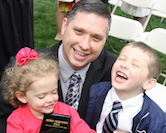
Outside the classroom, Jeff founded a state robotics competition and helped to create an ecology program to keep his students immersed in real-world activities and solutions. Of course, Jeff’s resume extends beyond these activities, but his teaching revolves around preparing students to meet the next phase of their lives through a variety of STEM experiences.
In my mind, Jeff is a real model for STEM teaching and learning. In addition to his innovative performance-based instruction, he’s the kind of person that I’d simply like to get to know. I believe you will enjoy getting to know Jeff better as well.
1. Tell us about the STEM programs you have spearheaded at Zillah High and elsewhere.
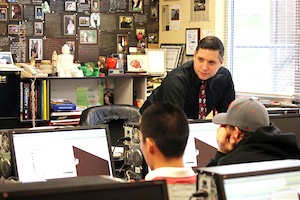
I aim to provide free, hands-on experiences in math and science education to any willing student, regardless of what school they attend. I maintain an open invitation to all schools in Washington State to participate in the program at no cost. Public, private, alternative and home schools are eligible. Through multiple years of fundraising, the Zillah Science Boosters have secured funding to purchase 100 Boe-Bot robot kits. The first 50 high school teams and the first 50 middle school teams that register for each competition are accepted. Each school can register a maximum of 4 teams, and the teams range in size from one to eight students.
Zillah High loans a kit to each team. Teams then work as part of an in-class, club or after-school program for about 6 weeks to learn how to assemble, program, test and modify their robots before the competition. Competition day features keynote speakers from around the state. Past presentations include the Washington State Patrol’s Bomb Squad Unit, the 53rd Explosives Ordinance Disposal unit of the US Army, and representatives from the Hanford Nuclear Facility.
Over 1200 students from more than 75 different middle and high schools throughout Washington State have participated in the 12 competitions so far. This past fall saw the most growth in the program — more than 85 teams from 27 different high schools and 59 teams from 17 middle schools paticipated in our December competitions.
2. How does the engineering design process change what happens in the classroom for your students?
Honestly I see the engineering design process as something that everyone can and should apply to their everyday lives. The basics of the design process can be broken down simply to asking some key questions about the part or scenario: What is working well? What needs to be improved? How can we improve it? And finally, did our improvements work, or do they need refinement?
In essence, that is what I teach my students to do, and that is how I run my classroom. I am constantly praising my students for what they have done correctly, while gently showing areas of need. Together we then work out our course of action to address that need. As such, I am constantly modifying and adapting my lesson plans to meet the individual needs of my students, by following the design process.
3. Do you find that all students can do STEM work? Do you have strategies to encourage girls, minorities, and students with special challenges?
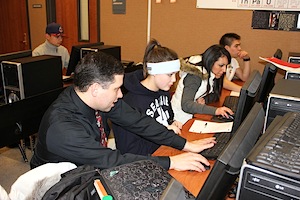
Why do these students succeed in my classroom? The answer is simple. When students walk through my door, I seek the positive in them first. I place my students as my absolute first priority. Content comes second. By learning first about my students – their history, culture, current ability, future goals, activities, etc, I am able to modify my instruction so that they can see the relevance of what they are learning in class to the things that matter to them in their lives.
Once that connection is made, it is the students who drive the instruction. They push me to show them more, and then I step to the side and allow them to do the work. Ironically, by placing positive student relationships before content in my priorities – we are studying subjects to a much deeper level; content rises when relationships come first.
So how do I encourage girls, minorities and students with special challenges? The same way I encourage all of my students – by getting to know them and showing them that I respect them as individuals, who bring value to not only my classroom, but to my own education as well.
4. What results do you see? Are more students going on to pursue STEM studies in college or careers?
I have seen a lot of positive coming from the STEM programs at my school. I can count several pharmacists, doctors, nurses, mechanical engineers, research microbiologists and chemists among my former students. Certainly I am proud of them. But I am equally proud of the musicians, beauticians, accountants, and business managers that have been my students too.
I see my job as a STEM teacher as not simply teaching the next generation of scientists, but as teaching the next generation as a whole. Every graduate today needs to be STEM-literate, regardless of profession. I take great pride in knowing that my students who are not in “STEM fields” can still see the connection to STEM in their lives and use that for their own advancement. Beauticians can and do benefit tremendously from a background in chemistry.
The reality is that paradise must be built, maintained and improved each day. It removes the words ‘can’t,’ ‘too hard’ and ‘impossible’ from our vocabulary. This concept has become my philosophy of teaching, as I foster self-confidence, academic success, collaboration and dedication within my classroom, school and greater community.” – Jeff Charbonneau
5. Tell us about your approach to teaching. What do you each day to be the best teacher you can be?
From my application, you will see my six strategies that I try to follow. There really is no order to them, though the first one is certainly the most important – I try to remember that “today is the most important day for every one of my students.” If I can remember that, really internalize it, then it drives me to do my best.
It means doing the simple things – greeting each person I see with a hello and a look in the eyes, making sure that I point out the positives in others, and that I am as consistent in my approach as possible, while still being flexible to each student’s needs. Stated another way, I try to remind myself that what I do today matters not just for one day, but can have a lasting impact for a lifetime for each of my students.
6. What, in your mind, are our most pressing concerns in strengthening STEM programs?
There are three main areas we need to address:
Student confidence. Far too many of our students dismiss upper division STEM offerings due to a lack of confidence in their own abilities. We need a combined voice from educators, parents and administration to convince students that they are, in fact, very capable of being successful in STEM fields. In my own classes, I have found that once I get a student in the door, they continue to come back. More importantly, they succeed.
Teachers. We need more STEM teachers. At the same time we need to understand and communicate the value of a well-rounded education from other fields. In my engineering classes, students with a background in art are better equipped to create perspective drawings. Students with a strong writing background create better design briefs and research papers. So as we continue to push for more STEM teachers, let us also recognize the need for quality teachers in all areas.
Funding. Unfortunately, STEM education is expensive. Particularly the “T” – Technology. A large number of our schools use grants and other similar programs to fund their STEM offerings. While this certainly is appreciated by those schools and has been a tremendous help in improving STEM education across our nation (and world), grants do not typically cover the on-going costs of replacing and upgrading programs.
Our engineering students need to have access to current technology – ranging from appropriate CAD software to robotics to CNC machinery. If our students are to leave school ready to contribute to their field, then they need to be learning current technology. Specific funding plans need to be in place in every school district to address STEM needs over the course of multiple years, taking into account technology upgrades and replacements.
 7. What else would you like to share with us?
7. What else would you like to share with us?
One of my goals this next year is to talk with pre-service teachers or those who are considering going into education. If given the opportunity to share a few words with those individuals, I would like to say the following:
First and foremost, choose your career and your area of expertise based on what you love; those who are greatest at their profession – whether teacher, nurse, accountant, or musician – see their work as their calling. If teaching is calling you, do not hesitate!
In the path to becoming a teacher, remember two things:
• Content is secondary. Building positive relationships with students always comes first. Connect with your students – learn about them as individuals who should be celebrated for their similarities and their differences. Be genuine in your interest in their backgrounds and utilize the information you learn about them in your lessons, as appropriate, to increase the relevance and impact of those lessons.
• Do more, expect more. Once those relationships are built with students, they will work hard for you. Have high expectations for what your students can do – in fact set the bar higher than even you expect them to reach. Then watch them reach the bar anyway. The surprising thing about making content secondary and putting relationships first is that you will be able to teach to a much greater depth, with more rigor than you ever expected. So challenge your students and challenge yourself to continue to improve every single day.
That’s what I’d like to share with all my colleagues, present and future.
Anne: It’s hard for me to pinpoint which of Jeff’s responses touches me the most…which would offer the best value for me as a teacher. I believe that the 6 teaching strategies that Jeff shared in his NTOY application (mentioned in his response to Question 4) were particularly powerful, as were his comments about the importance of a well-rounded education for STEM-focused students in middle and high school. You can hook up with Jeff by following him on Twitter @jeffcharbonneau
Photos: © Zillah High School, used with permission.


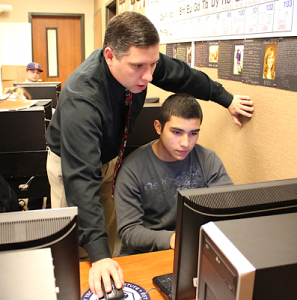
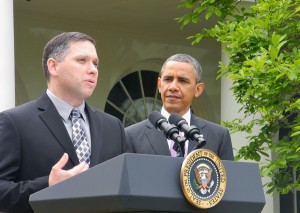





























Thank you, Jeff, for sharing your success and articulating your steps and strategies for building and sustaining a strong STEM program for ALL students. Your first priority of building relationships is so critical for any program and I would add that creating a safe environment where every student is heard and respected by others is another important factor in helping students build confidence in their abilities and competencies. When asked, “Why are our students losing interest in math and science once they move to middle and high school?” My response is that the students no longer feel important or that they count because content becomes the priority. I applaud you for bringing this disconnect to the forefront.
What an inspiring story! I agree with Anne that the teaching strategies Jeff shared are powerful. Those strategies promote an attitude of respect in the classroom that is essential to a productive learning environment. The classroom Jeff described is the type of classroom that I hope my grandchildren experience. Thank you for sharing his story.
Hey, Jeff— Judy took the words right out of my mouth —what an inspiring story!! Since Judy and I work together in mobile developing STEM curriculum (EYE Modules) -I’m not surprised!! To have our national teacher of the year be able to speak so passionately about the value of STEM for ALL students – and from personal experience- is incredibly valuable. Please keep up the good work- and perhaps there’s a way we could get you to come to Mobile and share your message in person—think about that and let me know if that’s possible. Anne can connect us if needed
Thank YOU”. Susan Pruet